Faraday entered a big metallic cage supported on insulating pillars and then charged the cage by a powerful electric machine. He remained quite safe inside the cage. Do you believe on this happening ?
Yes, As the cage is insulated, the entire charge remained on the outer surface of the cage remained the same. As there was no potential difference between any two points in the cage, Faraday could not get the shock and remained quite safe inside the cage.
Similar Questions
Faraday Cage:
A Faraday cage or Faraday shield is an enclosure made of a conducting material. The fields within a conductor cancel out with any external fields, so the electric field within the enclosure is zero. These Faraday cages act as big hollow conductors you can put things in to shield them from electrical fields. Any electrical shocks the cage receives, pass harmlessly around the outside of the cage.
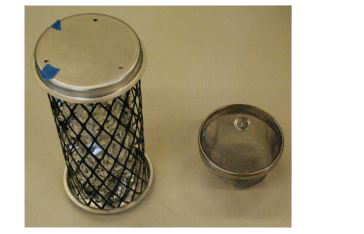
A point charge of 2C is placed at centre of Faraday cage in the shape of cube with surface of 9 cm edge. The number of electric field lines passing through the cube normally will beView SolutionFaraday Cage:
A Faraday cage or Faraday shield is an enclosure made of a conducting material. The fields within a conductor cancel out with any external fields, so the electric field within the enclosure is zero. These Faraday cages act as big hollow conductors you can put things in to shield them from electrical fields. Any electrical shocks the cage receives, pass harmlessly around the outside of the cage.
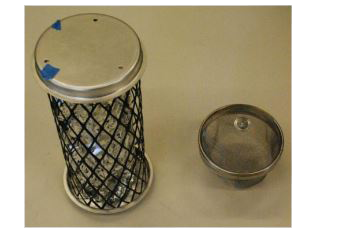
An isolated point charge +q is placed inside the Faraday cage. Its surface must have charge equal to-View SolutionFaraday Cage:
A Faraday cage or Faraday shield is an enclosure made of a conducting material. The fields within a conductor cancel out with any external fields, so the electric field within the enclosure is zero. These Faraday cages act as big hollow conductors you can put things in to shield them from electrical fields. Any electrical shocks the cage receives, pass harmlessly around the outside of the cage.
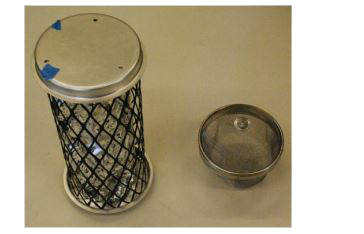
What is the electrical force inside a Faraday cage when it is struck by lightning?View SolutionFaraday Cage:
A Faraday cage or Faraday shield is an enclosure made of a conducting material. The fields within a conductor cancel out with any external fields, so the electric field within the enclosure is zero. These Faraday cages act as big hollow conductors you can put things in to shield them from electrical fields. Any electrical shocks the cage receives, pass harmlessly around the outside of the cage.
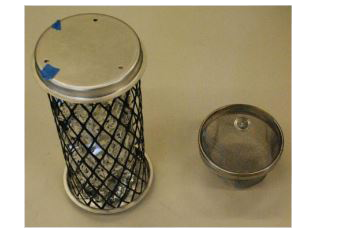
Which of the following material can be used to make a Faraday cage?View SolutionFaraday Cage:
A Faraday cage or Faraday shield is an enclosure made of a conducting material. The fields within a conductor cancel out with any external fields, so the electric field within the enclosure is zero. These Faraday cages act as big hollow conductors you can put things in to shield them from electrical fields. Any electrical shocks the cage receives, pass harmlessly around the outside of the cage.
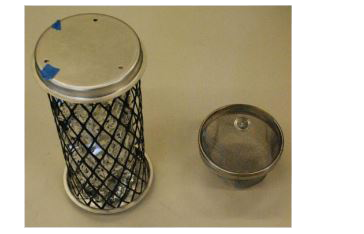
Example of a real-world Faraday cage isView SolutionAnswer the following:
(a) The top of the atmosphere is at about 400 kV with respect to the surface of the earth, corresponding to an electric field that decreases with altitude. Near the surface of the earth, the field is about 100Vm−1. Why then do we not get an electric shock as we step out of our house into the open? (Assume the house to be a steel cage so there is no field inside!)
(b) A man fixes outside his house one evening a two metre high insulating slab carrying on its top a large aluminium sheet of area 1m2. Will he get an electric shock if he touches the metal sheet next morning?
(c) The discharging current in the atmosphere due to the small conductivity of air is known to be 1800 A on an average over the globe. Why then does the atmosphere not discharge itself completely in due course and become electrically neutral? In other words, what keeps the atmosphere charged?
(d) What are the forms of energy into which the electrical energy of the atmosphere is dissipated during a lightning? (Hint: The earth has an electric field of about 100Vm−1 at its surface in the downward direction, corresponding to a surface charge density =10−9Cm−2. Due to the slight conductivity of the atmosphere up to about 50 km (beyond which it is good conductor), about +1800C is pumped every second into the earth as a whole. The earth, however, does not get discharged since thunderstorms and lightning occurring continually all over the globe pump an equal amount of negative charge on the earth.)View SolutionA capacitor is an arrangement for storing large amounts of electric charge and hence electric energy in a small space.
The electrical capacitance of a capacitor is related to its abillity to store electric charge. We define capacity of a conductor as the ratio of charge Q given to the conductor to the rise in its potential, V i.e., C=Q/V. The capacity of an isolted spherical conductor of radius r is C=4π∈0r. In case of a parallel plate capacitor, C=∈0Ad where A is area of insulated metal plate and d is distance between the plates. Clearly, capacity depends on size of capacitor.
When different capacitors are connected in series, capacity, Cs=C1C2C1+C2 and when capacitors are connected in parallel, Cp=C1+C2
Read the above passage and answer the following questions :
(i) From C=QV, we find that C can be increased Q or decresing V. Do you agree ?
(ii) Capacity of a capacitor is fixed depending on its geometry and the medium used. Is it true ?
(iii) Calculate the capacity of a condenser which when connected in series with a conductor of 12μF gives us a capacitance of 3μF.
(iv) What values of life do yo+-earn from this study ?View SolutionTEXT I
You have read how Wanda was passionate about her talent and pursued it in spite of so many hurdles. Wangari Mathai, the Nobel Prize winner, is another person who fought a battle to save the environment. She had a humble start but she dreamt big and succeeded.
Read the following passage and answer the questions that follow.
When we said we wanted to plant fifteen million trees, a forester laughed and said we could have as many seedlings, as we wanted because he was convinced that we could not plant that many trees. Before too long, he had to withdraw that offer because we were collecting more trees than he could give away free of charge. But we didn't' t have the money. We decided that we could produce the seedlings ourselves. We would go and collect seeds from trees, come back, and plant them the way women planted other seeds - beans, corn, and other grains. And so the women actually developed forestry management techniques, using "appropriate technology" to fit their needs. Here is the basic method - take a pot, put in the soil, and put in the seeds. Put the pot in an elevated position so that the chickens and the goats don't come and eat the seedlings. Ordaining all the inventive techniques that the women developed, for example, sometimes trees produce seeds carried by the wind. These germinate in the fields with the first rain. It was very interesting to see a woman cultivating a field with a small container of water. But, she was cultivating weeds! She had learned that among these weeds were also tree seedlings and that she could pick the seedlings and put them in a container. In the evening, she went home with several hundred seedling trees! These techniques developed by the women became extremely helpful. We planted more than twenty million trees in Kenya alone. In other African countries, we have not kept records. Trees are alive, so we react to them in very different ways. Quite often, we get attached to a tree, because it gives us food and fodder for our fires. It is such a friendly thing. When you plant a tree and you see it grow, something happens to you. You want to protect it, and you value it. I have seen people really change and look at trees very differently from the way they would in the past. The other thing is that a lot of people do not see that there are no trees until they open their eyes, and realise that the land is naked. They begin to see that while rain can be a blessing, it can also be a curse, because when it comes and you have not protected your soil, it carries the soil away with it. And this is rich soil in which you should be growing your food, then they see the immediate relationship between a person and the environment. It is wonderful to see that transformation, and that is what sustains the movement!
(Source: 'Speak Truth to Power' by Wangari Mathaai)
A forester laughs when Wangari Mathai says that they wanted to plant 15 million trees. Why did the forester react in this manner?View SolutionTEXT I
You have read how Wanda was passionate about her talent and pursued it in spite of so many hurdles. Wangari Mathai, the Nobel Prize winner, is another person who fought a battle to save the environment. She had a humble start but she dreamt big and succeeded.
Read the following passage and answer the questions that follow.
When we said we wanted to plant fifteen million trees, a forester laughed and said we could have as many seedlings, as we wanted because he was convinced that we could not plant that many trees. Before too long, he had to withdraw that offer because we were collecting more trees than he could give away free of charge. But we didn't' t have the money. We decided that we could produce the seedlings ourselves. We would go and collect seeds from trees, come back, and plant them the way women planted other seeds - beans, corn, and other grains. And so the women actually developed forestry management techniques, using "appropriate technology" to fit their needs. Here is the basic method - take a pot, put in the soil, and put in the seeds. Put the pot in an elevated position so that the chickens and the goats don't come and eat the seedlings. Ordaining all the inventive techniques that the women developed, for example, sometimes trees produce seeds carried by the wind. These germinate in the fields with the first rain. It was very interesting to see a woman cultivating a field with a small container of water. But, she was cultivating weeds! She had learned that among these weeds were also tree seedlings and that she could pick the seedlings and put them in a container. In the evening, she went home with several hundred seedling trees! These techniques developed by the women became extremely helpful. We planted more than twenty million trees in Kenya alone. In other African countries, we have not kept records. Trees are alive, so we react to them in very different ways. Quite often, we get attached to a tree, because it gives us food and fodder for our fires. It is such a friendly thing. When you plant a tree and you see it grow, something happens to you. You want to protect it, and you value it. I have seen people really change and look at trees very differently from the way they would in the past. The other thing is that a lot of people do not see that there are no trees until they open their eyes, and realise that the land is naked. They begin to see that while rain can be a blessing, it can also be a curse, because when it comes and you have not protected your soil, it carries the soil away with it. And this is rich soil in which you should be growing your food, then they see the immediate relationship between a person and the environment. It is wonderful to see that transformation, and that is what sustains the movement!
(Source: 'Speak Truth to Power' by Wangari Mathaai)
What role does money play in the given extract?View SolutionTEXT I
You have read how Wanda was passionate about her talent and pursued it in spite of so many hurdles. Wangari Mathai, the Nobel Prize winner, is another person who fought a battle to save the environment. She had a humble start but she dreamt big and succeeded.
Read the following passage and answer the questions that follow.
When we said we wanted to plant fifteen million trees, a forester laughed and said we could have as many seedlings, as we wanted because he was convinced that we could not plant that many trees. Before too long, he had to withdraw that offer because we were collecting more trees than he could give away free of charge. But we didn't' t have the money. We decided that we could produce the seedlings ourselves. We would go and collect seeds from trees, come back, and plant them the way women planted other seeds - beans, corn, and other grains. And so the women actually developed forestry management techniques, using "appropriate technology" to fit their needs. Here is the basic method - take a pot, put in the soil, and put in the seeds. Put the pot in an elevated position so that the chickens and the goats don't come and eat the seedlings. Ordaining all the inventive techniques that the women developed, for example, sometimes trees produce seeds carried by the wind. These germinate in the fields with the first rain. It was very interesting to see a woman cultivating a field with a small container of water. But, she was cultivating weeds! She had learned that among these weeds were also tree seedlings and that she could pick the seedlings and put them in a container. In the evening, she went home with several hundred seedling trees! These techniques developed by the women became extremely helpful. We planted more than twenty million trees in Kenya alone. In other African countries, we have not kept records. Trees are alive, so we react to them in very different ways. Quite often, we get attached to a tree, because it gives us food and fodder for our fires. It is such a friendly thing. When you plant a tree and you see it grow, something happens to you. You want to protect it, and you value it. I have seen people really change and look at trees very differently from the way they would in the past. The other thing is that a lot of people do not see that there are no trees until they open their eyes, and realise that the land is naked. They begin to see that while rain can be a blessing, it can also be a curse, because when it comes and you have not protected your soil, it carries the soil away with it. And this is rich soil in which you should be growing your food, then they see the immediate relationship between a person and the environment. It is wonderful to see that transformation, and that is what sustains the movement!
(Source: 'Speak Truth to Power' by Wangari Mathaai)
"When you plant a tree and you see it grow, something happens to you." Explain what do you understand by the above quote.View Solution

